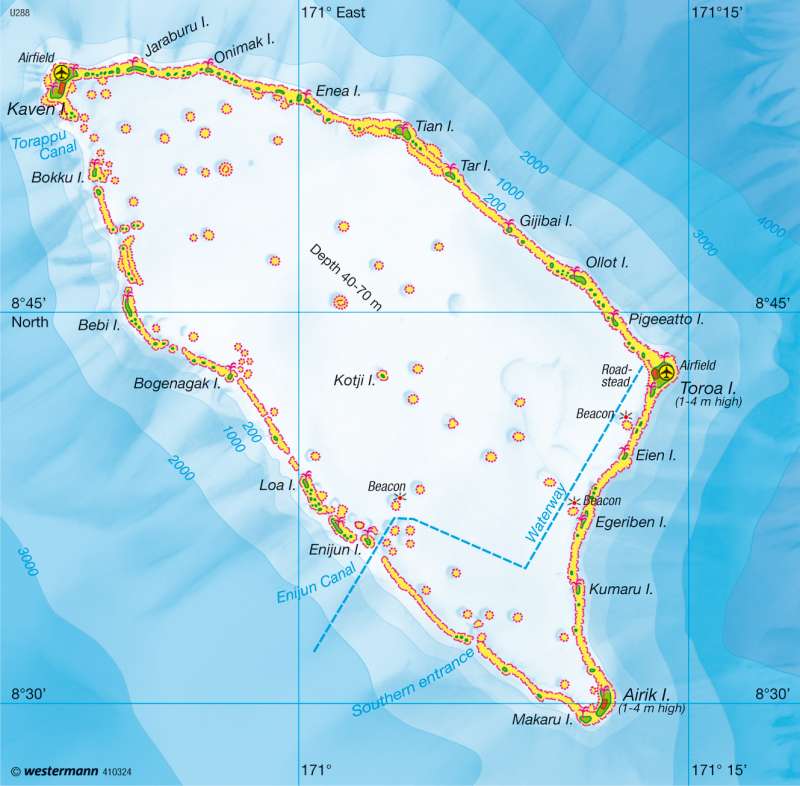Maloelap Atoll (Marshall Islands)
Australia/Oceania - Physical
978-3-14-100790-9 | Page 117 | Ill. 3

Information
An atoll is a circular or oval-shaped coral reef with sea levels rising over an island, together with a lagoon in the centre. Stony corals and coralline algae form the community of reef life. Certain environmental conditions are necessary for the growth of coral reefs: The sea water must have a minimum temperature of 20 °C and a salt content of 3.5 percent. In addition, it should be rich in oxygen, strong moving and with enough light - the occurrence limit of coral is to a depth of about 25 metres. Because of these very special requirements, the proliferation of coral reefs in the tropical zones, is limited to between 30 degrees to the north and 30 degrees the south latitude.Formation of atolls
The Darwinian Theory from 1842 explains the origin of atolls. It is first formed as a fringing reef and then becomes a barrier reef during the slow subsidence of a volcanic island. The reef growth is from 1 to 25 millimetres per year, keeping pace with the sea level. As a result, the reef surface always stays close to the sea level. When the volcanic island has eventually disappeared, it is replaced by a lagoon. The reef itself is composed of the skeletons of dead corals. The optimal growth conditions can be found on the seaward side of the reef where the surging waves are in the wind. The reef on the seaward side is horizontally extended and the waste is deep, at a horizontal distance of ten kilometres to over 4,000 metres.
For the lagoon, which is only 40 to 60 metres deep, the waste must be flat. The lagoon has several outlets to the open sea located in the leeside of the surf (reef canals, passages), where the water can run through the entrapped lagoon. They also serve as a protection for ships entering the lagoon. Coral rubble and sand from the continuously disturbed windward side reef crest, which acts like a breakwater, stands out up to four feet above the flood line with individual islands. The elongated island's land area is very low, formed at approximately 200 to 400 metres wide. The Maloelap Atoll example shows only about 6 km² land area in a lagoon area of 600 sq kilometres. Maloelap belongs to the Republic of Marshall Islands and the surrounding sea, which has an area of 2 million km² (within the 200 nautical-mile zone) and exhibits a land area of only 180 km².
Frugal living conditions
The South Sea is next to the Indian Ocean (Maldives), the main habitat of atolls. Because of the meager living conditions there, the population is most prominently found in the outlying atolls. The most important nutritional foundation comes from the frugal coconut trees, which aged ten years, usually provide over 50 high-fat coconuts per tree, for about 60 years. The protein needs of atoll dwellers are covered by marine animals that are collected on the dry reef at low tide. Taro, a starch-rich tuber, is planted in artificial pits.
R. Pertsch; Ü: Colette Fleming




